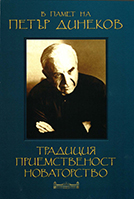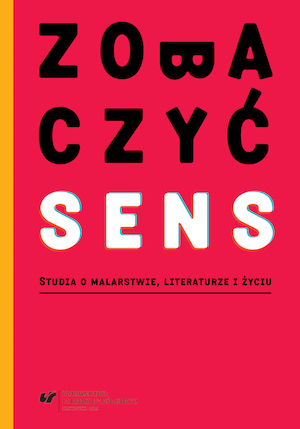
We kindly inform you that, as long as the subject affiliation of our 300.000+ articles is in progress, you might get unsufficient or no results on your third level or second level search. In this case, please broaden your search criteria.











This text is an introduction to the problem discussed in the entire book. At the beginning,a literary diagnosis of contemporaneity has been made, which shows that modern individualsare not capable of discovering or discerning the sense of life or of any of their actions. In thefurther part, philosophical possibilities for deliberating about sense in its ontological, axiologicaland praxeological dimensions (not only the “common” — sensual ones that have been examinedso far) have been indicated. In the last part, a reference to art has been made, which concernsnot only exemplary literary and artistic works analysed in the book, but also the philosophy ofcreation and the questions that artists ask themselves with regard to the aim and the methodsof their activity.
More...
The author (who simultaneously is a painter) reflects on various aspects of the philosophy ofcreation. First, he pays attention to the capacity of the word “sense” — what it traditionally meant(relating mainly to sensual cognition), and which problems (suggested in the title) the contemporarypeople have to face. Referring to philosophical texts, the author of the article proves thatthe sense of art consists in going beyond the current existence and that it is always establishedin relation to the audience. It should be also remembered that the process of creation is alwayshazardous, just like life choices are, yet that this is the risk that a human being is bound to take.At the end of the article, the weak points of anti‑arthave been presented, the representatives ofwhich cravenly depreciate the value of the fundamental question: “Why?”
More...
The text presents deliberations of a painter on the individual aspect of a creative process.The author asks a provocative question whether everything that is presently created may beconsidered as art. At the obtained level of collective (or tribal) evolution, we have reached thestate of lack of balance between technological capacities and the development of individuality.According to the author, collective actions rarely bring sensible results. With noticeable concern,the author observes the contemporary plethora of images, chaos and haste, yet he concludesthat time is, and will be, the final verifier of values. He opts for the attitude that aims at savingindividual human dignity which may be found in the sense of responsibility and in the desire tosearch for truth. At the end of the article a question and a thesis are formulated, which regardthe conformity between ideological and artistic choices.
More...
The author presents a vast, and constantly developed artistic project of Maciej Linttner, whichthe title closet represents. It contains chests in which the artifacts collected, transformed and createdby the artist (including literary works) are being stored. The author of the article pays specialattention to the communicative aspects. On the one hand, in Linttner’s work she discerns theconception of a weak subject — a nomadic subject thrown into the postmodern grid without anyhierarchy, but on the other hand, she sees the necessity of the creative contribution the recipientshave to make to compile the selected senses for their own use. Linttner experiments, persistentlytrying to identify himself. Simultaneously, the artist believes in the universal character of theconveyed message and, aware of the risk, he submits to the verifying power of time.
More...
The article illustrates the proximity of artistic attitudes of Jan Józef Szczepański, a writer,and Tadeusz Brzozowski, a painter. It presents the history of a deep and long‑lastingfriendshipbetween these two artists. On the basis of literary creations and diary entries of Jan JózefSzczepański, it attempts to reconstruct the ethical attitudes and artistic choices declared andadopted by both artists. Indicating a number of differences between them, the article aims atpresenting the essence of artistic activity which they both represented and which has its sourcein the indissoluble connection between ethics and aesthetics.
More...
Conrad answers Stein’s question — “How to be”? — ever anew. He repeats that moral normsare always valid, regardless of the circumstances or some greater necessity. Owing to that attitude,Conrad became a moral guide to young Poles during the war, occupation and the time of theCommunist regime. Also today, the Conradian ethos makes it possible to preserve “faithfulnessto something significantly moral and valuable.” Conrad regards the Mediterranean tradition to bethe source of European culture and civilisation and the foundation, without which nothing couldbe achieved either in the spiritual or the material sphere. It is this particular tradition that formedConrad’s views and allowed him, in turn, to form the views of the consecutive generations ofreaders (which he still continues to do).
More...
The works of Joseph Conrad (and, more specifically, their Polish translations) were frequentlyused in political debates. Many critics read their own contents into his works, and used Conradas an exemplum illustrating arguments they had advanced. This article is an analysis of the manipulationswhich Conrad’s works were subjected to in Poland. The analysis has been conductedwith the use of terminology applied in the descriptive studies on translation. In the article, theauthor focuses on the distortions of Conrad’s translated works, which resulted from the continuousinfluences of various ideologies. To this end, terms such as: re‑writing,refraction and patronage,introduced into translation studies by André Lefevere, have been used.
More...
The article presents a distinguished historian and literary critic, Kazimierz Wyka, not only asa philosopher of history, but also in a new role of an expert in military craft. A careful readingof Wyka’s essays allowed the author to reconstruct the evolution of the critic’s views (as he wasengaged in the aspects of military system not only during the war, but he recalled this theme duringthe following anniversaries) concerning the causes of the Polish defeat in September 1939. Wykaanalysed the military, economic, propagandist, political and social issues. As a literary scholar, hewas also interested in these problems being discussed — unfortunately, not thoroughly enough —by writers. Subjectively, he emphasised Polish moral claims that determined the fundemental senseof the “Polish September”.
More...
The article is devoted to the analysis of literary texts and diary entries of J.J. Szczepański,in the context of the broadly understood problem of home. The writer presents home (in variousmoments of his life) as an archetypal place of rooting, as an asylum, a haven — a place of departuresand returns. The author of the article recalls data concerning autobiographical characterof Szczepański’s writing, and she draws the readers’ attention to the fact that his observationscorrespond to the fundamental theses of the oikological reflection.
More...
vSearching for the Third Sense. About the Interference of Arts in the Works of Jarosław IwaszkiewiczIn the works of Jarosław Iwaszkiewicz various forms of art (especially musical and visualarts) often co-exist. The interference of arts, in this case, is limited to the formal experiments(regarding eg. musicality of a poem, or lexical devices which serve the purpose of language visu-alisation), and it becomes a method of searching for the more profound sensations in visual arts,which results in discovering new senses through art. Adopting Roland Barthes’s terminology, thisprocess may be defined as an attempt to determine an open sense — the so called third sense.In case of Iwaszkiewicz’s works, most often this sense is of metaphysical nature.
More...